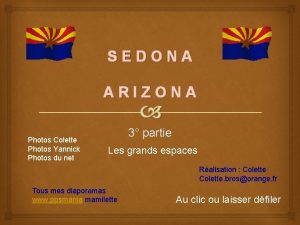PHOTOS Composition is the key PHOTO COMPOSITION In















































- Slides: 47

PHOTOS Composition is the key

PHOTO COMPOSITION In order to shoot and then be able to choose great photographs, you need to have a plan.

PHOTO COMPOSITION • Photo composition refers to the arrangement of elements in a photograph. • While the average viewer cannot define what this is, YOU can help make the photo more effective by understanding how to control composition.

RULES OF COMPOSITION Think of these guidelines as you compose the photos you take. • Rule of thirds • Framing • Center of interest • Balance • Leading lines and curves • Pattern and repetition • Camera angle

RULE OF THIRDS Sedona Alvarez, Mill Valley H. S. Use this basic guideline for a well-balanced, pleasing image. First, divide the frame into thirds both horizontally and vertically. Then, place the subject at the intersection of any two lines.

RULE OF THIRDS Sam Johnson, East Lansing H. S. Using this guideline of placing the center of interest in one of the intersections, you can allow the action to flow into the photo.

RULE OF THIRDS Try it. “Draw” the lines on each photo and notice where your eyes go. Chris Hanewinckel, KSU Matt Foss, West Henderson H. S. Karen Kim, Westfield H. S.

FRAMING When you “frame” a photo, you place objects in the foreground to give the illusion of three dimensions. Note that the book in the foreground is slightly out of focus to lead your eye to the girls, who is reading. Erin De La Rosa, Smoky Hill H. S.

FRAMING Alan Dicker, Smoky Hill H. S. The most effective framing occurs when the object in the foreground helps to tell the story of the photograph, as shown in these examples.

FRAMING Karl Sparrman, Mill Valley H. S. Kylie Chapman, Mill Valley H. S. Lee. Ann Elias, Oakton H. S. Framing allows you to add interest to academic photos.

FRAMING Kristen Mrozowski, East Lansing H. S. Thanks to Homecoming floats, you sometimes get the chance to literally “frame” your photo!

CENTER OF INTEREST Chris Hanewinckel, KSU Control where the eye goes first by having one dominant element in each photo. If there is not center of interest, there is no reason to take the photo.

CENTER OF INTEREST Lily Krupp, West Henderson H. S. Another reason to get in close is to eliminate any possible distracting backgrounds.

CENTER OF INTEREST The basic elements of composition often work together. This photo uses the rule of thirds, shallow depth of field and fast shutter speed to create a vivid center of interest. Chris Hanewinckel, KSU

CENTER OF INTEREST Alexandra Tapang, Mill Valley H. S. When in doubt, look at the eyes. They will often pull you into the photo. Karen Kim, Westfield H. S.

CENTER OF INTEREST Kristen Mrozowski, East Lansing H. S. Whether you have a single subject or many, there needs to be one center of interest.

BALANCE Soranie Hirpo, East Lansing H. S. Place the main subject(s) a little off center, because informal balance is more pleasing to the eye than formal balance.

BALANCE Justin Cheung, Westfield H. S. Notice how the placement of the people in the photo adds to the photo’s sense of balance.

BALANCE Annie Kennedy, Pleasant Valley H. S. Athletes often convey balance as they are in motion. Chris Hanewinckel, KSU Alan Dicker, Smoky Hill H. S.

LEADING LINES/CURVES Chris Hanewinckel, KSU Lines and curves direct the viewer’s attention to the center of visual interest.

LEADING LINES/CURVES Matt Foss, West Henderson H. S. Where you stand to take the picture helps determine the effectiveness of strong leading lines.

LEADING LINES/CURVES Lee. Ann Elias, Oakton H. S. Curves are also effective at drawing the viewer into the photo.

LEADING LINES/CURVES Skylar Williams, Basic H. S. In general, diagonal lines have a greater impact than horizontal lines.

LEADING LINES/CURVES Make it a practice to look for leading lines in unexpected places as they will lead to more dynamic photographs. Arturo Reyes, Oxnard H. S.

PATTERN AND REPETITION Chris Hanewinckel, KSU While patterns draw the reader into the picture, it’s the break in the repetition that proves interesting.

PATTERN AND REPETITION Kristi Paukstis, Smoky Hill H. S. Notice how the pattern in the chain link fence is broken by freshmen escaping closed campus.

PATTERN AND REPETITION Chris Hanewinckel, KSU Sometimes repetition is found with the people themselves rather than in objects in the photo.

CAMERA ANGLE Chris Hanewinckel, KSU Move around. Take shots from above, from below, from one side and then another.

CAMERA ANGLE Grant Cooper Richardson, Mc. Clintock H. S. Ellen Gatewood, Mill Valley H. S. Creative camera angles can be especially effective when photographing sports action.

CAMERA ANGLE Lee. Ann Elias, Oakton H. S. Everything, from activities to academics, can be shown more effectively with a creative camera angle.

CAMERA ANGLE Chris Hanewinckel, KSU With the right camera angle, not only is the center of interest clear, but the impact is amazing.

TIPS TO BETTER PHOTOS Consider these principles as you prepare to take pictures at any event. • Keep it simple • Move close • Be aware of light • Capture emotions • Tell the entire story

KEEP IT SIMPLE Travis Ladue, Corona del Sol H. S. Ask yourself: What am I photographing? Then move around and shoot your subject.

Greg Glatz, East Lansing H. S. Kylie Chapman, Mill Valley H. S. Ellen Gatewood, Mill Valley H. S.

Chris Hanewinckel, KSU Lennon Mc. Cartney, Westfield H. S. Justin Cheung, Westfield H. S.

MOVE CLOSE Courtesy of Kim Hanzo Ask yourself: What am I photographing? Then move close and shoot your subject.

Kylie Chapman, Mill Valley H. S.

Courtney Harrington, Mill Valley H. S. Sedona Alvarez, Mill Valley H. S. Kylie Chapman, Mill Valley H. S.

USE LIGHT KNOWINGLY Light can be your best friend — or your worst enemy. Be aware of where your light source is and then use it to help you tell your story. Chris Hanewinckel, KSU

Kylie Chapman, Mill Valley H. S. Justin Cheung, Westfield H. S. Alan Dicker, Smoky Hill H. S.

Chris Hanewinckel, KSU Kylie Chapman, Mill Valley H. S. Lennon Mc. Cartney, Westfield H. S.

CAPTURE EMOTIONS Chris Hanewinckel, KSU Look for the reaction to the action, the response to events to capture emotion. Don’t be afraid to photograph both the agony and the joy.

Skylar Williams, Basic H. S. Chris Hanewinckel, KSU Lennon Mc. Cartney, Westfield H. S.

TELL THE ENTIRE STORY Lennon Mc. Cartney, Westfield H. S. Show more than the event, the action on the field, the obvious.

(all photos taken by photographers from Westfield H. S. )

SO WHAT’S YOUR PLAN? Emily Rath, Pleasant Valley H. S. Stacey Lo, Pleasant Valley H. S. • Break through the barriers and take off running. • Get great shots. • Bask in the praise of those who appreciate your great photos.

PHOTOGRAPHY Created in conjunction with Kathy Daly Herff Jones Special Consultant A special thanks to all the student photojournalists who contributed to this presentation.
 These are photos from your photo album впр
These are photos from your photo album впр These are photos from your photo album
These are photos from your photo album Key partners key activities key resources
Key partners key activities key resources Business model canvas tripadvisor
Business model canvas tripadvisor Hình ảnh bộ gõ cơ thể búng tay
Hình ảnh bộ gõ cơ thể búng tay Slidetodoc
Slidetodoc Bổ thể
Bổ thể Tỉ lệ cơ thể trẻ em
Tỉ lệ cơ thể trẻ em Chó sói
Chó sói Thang điểm glasgow
Thang điểm glasgow Chúa sống lại
Chúa sống lại Môn thể thao bắt đầu bằng từ đua
Môn thể thao bắt đầu bằng từ đua Thế nào là hệ số cao nhất
Thế nào là hệ số cao nhất Các châu lục và đại dương trên thế giới
Các châu lục và đại dương trên thế giới Công thức tính thế năng
Công thức tính thế năng Trời xanh đây là của chúng ta thể thơ
Trời xanh đây là của chúng ta thể thơ Cách giải mật thư tọa độ
Cách giải mật thư tọa độ 101012 bằng
101012 bằng Phản ứng thế ankan
Phản ứng thế ankan Các châu lục và đại dương trên thế giới
Các châu lục và đại dương trên thế giới Thể thơ truyền thống
Thể thơ truyền thống Quá trình desamine hóa có thể tạo ra
Quá trình desamine hóa có thể tạo ra Một số thể thơ truyền thống
Một số thể thơ truyền thống Cái miệng xinh xinh thế chỉ nói điều hay thôi
Cái miệng xinh xinh thế chỉ nói điều hay thôi Vẽ hình chiếu vuông góc của vật thể sau
Vẽ hình chiếu vuông góc của vật thể sau Biện pháp chống mỏi cơ
Biện pháp chống mỏi cơ đặc điểm cơ thể của người tối cổ
đặc điểm cơ thể của người tối cổ Giọng cùng tên là
Giọng cùng tên là Vẽ hình chiếu đứng bằng cạnh của vật thể
Vẽ hình chiếu đứng bằng cạnh của vật thể Vẽ hình chiếu vuông góc của vật thể sau
Vẽ hình chiếu vuông góc của vật thể sau Thẻ vin
Thẻ vin đại từ thay thế
đại từ thay thế điện thế nghỉ
điện thế nghỉ Tư thế ngồi viết
Tư thế ngồi viết Diễn thế sinh thái là
Diễn thế sinh thái là Dạng đột biến một nhiễm là
Dạng đột biến một nhiễm là Bảng số nguyên tố
Bảng số nguyên tố Tư thế ngồi viết
Tư thế ngồi viết Lời thề hippocrates
Lời thề hippocrates Thiếu nhi thế giới liên hoan
Thiếu nhi thế giới liên hoan ưu thế lai là gì
ưu thế lai là gì Khi nào hổ con có thể sống độc lập
Khi nào hổ con có thể sống độc lập Sự nuôi và dạy con của hổ
Sự nuôi và dạy con của hổ Hệ hô hấp
Hệ hô hấp Từ ngữ thể hiện lòng nhân hậu
Từ ngữ thể hiện lòng nhân hậu Thế nào là mạng điện lắp đặt kiểu nổi
Thế nào là mạng điện lắp đặt kiểu nổi Percent composition of m&m lab
Percent composition of m&m lab Chapter 4 body weight and composition answer key
Chapter 4 body weight and composition answer key







































































